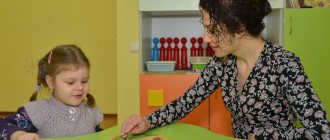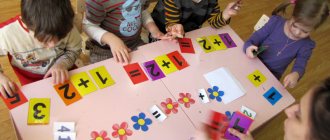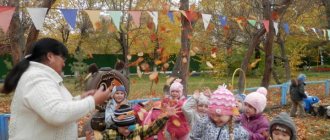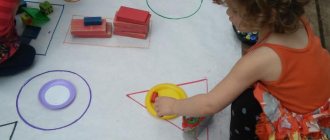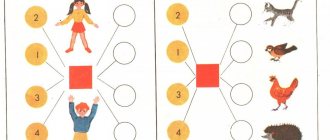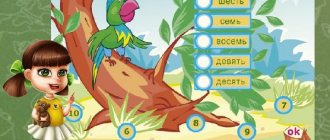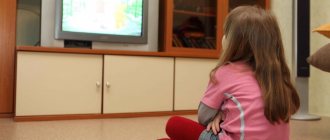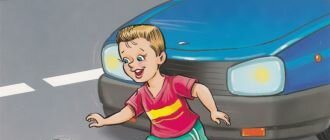Outdoor games for children 5-7 years old according to FEMP
Pedagogical article “Formation of elementary mathematical concepts through outdoor games in children of senior preschool age”
Purpose : the article is intended for educators, teachers and parents Purpose : to introduce the relationship between mathematical concepts and outdoor games for preschoolers. Article: Physical qualities that are inherent in a person from birth must be developed from early childhood and throughout life.
Correct execution of movements has a positive effect on the child’s health. Physical education classes allow you to introduce and teach children not only general developmental exercises and basic types of movements. In physical education, children become more proactive and relaxed, so such classes are possible to consolidate and improve knowledge in the development of speech, mathematics and other areas of activity. So, to consolidate and repeat mathematical concepts, you can use outdoor games. The widespread use of game methods in teaching and education in kindergarten has a number of advantages. Play, in this case active, is a natural state, a need of the child’s body, a means of communication and a joint activity of children. The game reveals the child’s individual abilities and allows one to determine the level of his knowledge and ideas. Outdoor play is both educational and playful in nature. When selecting outdoor games, attention is paid to the degree of difficulty of the game rules and actions. When consolidating mathematical concepts, outdoor games are classified: quantitative counting, magnitude, orientation in space, orientation in time and classification of objects. At the same time, conditions are created. which allow you to increase the effectiveness of learning and consolidation of material: - the correct selection of outdoor games depending on the purpose and age characteristics; -knowledge of the characteristics of the body and the conduct of outdoor games; -use of various methods and techniques for organizing and directing outdoor games; -supporting interest, teaching children to independently organize play activities. In the process of conducting outdoor games, children practice mental calculation, the ability to navigate in space and time, compare quantities, and develop the ability to distinguish and name geometric shapes. Games are often used that include tasks for logical thinking, the development of memory, attention, thinking, and imagination. Children consolidate their understanding of quantitative counting, the connection between numbers (more or less), and develop the ability to distinguish and name geometric shapes. One of the most beloved was the game “Owl” (time orientation). The number of those caught or “frozen” is counted at the end of each game (quantitative count), “We are funny guys” (quantitative count); “Find a pair”, “Colored figures” (value); “Entertainers”, “Faster to places”, “Sly fox”, “Empty space” (orientation in space); “Day - Night”, “Fun Week”, “Continue” (time orientation) Examples of games
Outdoor game “Day and Night”. (orientation in time, part of the day) In the middle of the site, two parallel lines are marked, along which two teams line up with their backs to each other - “Day” and “Night”. In front of each of the teams there is a “house” 10–15 meters away. The presenter says the name of the team, and she runs to her house. The task of the second team is to manage to defeat the maximum number of opponents... The outdoor game “Day and Night” helps preschool children train coordination of movements, reaction, and attentiveness. The game is perfect as active entertainment in kindergarten. Parents can play with their children and their friends while walking in the yard and play outdoor games. A flat area without objects that interfere with free and safe movement is suitable for playing. At the beginning of the game, a driver is selected. He turns away from the other participants in the game and loudly announces: “Day!” The players are having fun, jumping and running around the court. According to the terms of the game, you cannot stay still. After some time, the driver says: “Night!” At this moment, the participants in the game must instantly “fall asleep” - freeze in the position in which the “night” command caught him. The driver looks around, and if he notices a player who did not have time to “fall asleep,” he loudly announces this, indicating what kind of movement he noticed. The loser becomes the driver. Children especially like to risk becoming a loser... Game “Owl” ( orientation in time, space) Children stand in a circle. One of the players goes to the middle of the circle, he will depict an owl, and all the rest will depict bugs, butterflies, birds. At the command of the presenter: “The day comes - everything comes to life!” - kids run in circles. The owl is “sleeping” at this time, i.e. stands in the middle of the circle, eyes closed, one leg bent under him. When the leader commands: “Night comes - everything freezes!”, the players stop and stand motionless, hiding, and at that moment the owl runs out to hunt. She looks out for those who are moving or laughing, and takes the guilty ones into her circle. They become owls, and when the game is repeated, they all “fly out” to hunt together. Outdoor game “Sly Fox” (spatial orientation) Purpose: To develop endurance and observation in children. Practice running quickly with dodging, lining up in a circle, and catching. Description: The players stand in a circle at a distance of one step from each other. The fox's house is outlined outside the circle. The teacher invites the players to close their eyes, walks around the circle behind the children and says, “I’m going to look for a cunning and red fox in the forest!”, touches one of the players, who becomes a cunning fox. Then the teacher invites the players to open their eyes and carefully look to see which of them is the sly fox, and whether she will give herself away in some way. The players ask in chorus 3 times, first quietly, and then louder, “Sly fox, where are you?” At the same time, everyone looks at each other. The sly fox quickly goes to the middle of the circle, raises his hand up, and says “I’m here.” All the players scatter around the site, and the fox catches them. The caught fox takes him home to his hole. Rules: The fox begins to catch children only after the players ask in chorus 3 times and the fox says “I’m here!” Outdoor game “We are funny guys” (quantitative counting) Purpose: To develop in children the ability to perform movements according to a verbal signal. Practice running in a certain direction while dodging. Promote speech development. Description: Children stand on one side of the playground. A line is drawn in front of them. A line is also drawn on the opposite side. On the side of the children, in the middle, between the two lines, there is a trap assigned by the teacher. The children say in unison: “We are cheerful guys, we love to run and jump, well, try to catch up with us. One, two, three, catch!” After the word “catch,” the children run to the other side of the playground, and the catch catches up with those running. The one who is touched by the trap before the player crosses the line is considered caught and sits down near the trap. After 2-3 runs, the caught ones are recounted and a new trap is selected. Rules: You can only cross to the other side after the word “catch”. The one touched by the trap moves aside. The one who crossed to the other side, beyond the line, cannot be caught. Options: Introduce a second trap. On the way of those escaping there is an obstacle - running between objects. Outdoor game “Two Frosts” (time orientation, quantitative calculation, comparison of two groups) Purpose: To develop inhibition in children, the ability to act on a signal (by a word). Practice running while dodging while catching. Promote speech development. Description: On opposite sides of the site, two houses are marked with lines. The players are located on one side of the court. The teacher selects two drivers, who stand in the middle of the area between the houses, facing the children. These are Red Nose Frost and Blue Nose Frost. At the teacher’s signal “Begin,” both Frosts say: “We are two young brothers, two frosts are daring. I am Frost Red Nose. I am Frost Blue Nose. Which one of you will decide to set out on the path?” All the players answer: “We are not afraid of threats and we are not afraid of frost” and run to the house on the opposite side of the site, and the Frosts try to freeze them, i.e. touch with your hand. The frozen ones stop where they were caught in the frost and stand like that until everyone else has finished running. The frozen ones are counted, and then they join the players. Rules: Players can run out of the house only after the word “frost”. Whoever runs out first and whoever stays in the house is considered frozen. The one touched by Frost immediately stops. You can only run forward, but not backward or outside the area. Options: Behind one line are the children of Blue Frost, behind the other are the children of Red Frost. At the signal “blue”, the blue ones run, and Red Frost catches and vice versa. Who will catch the most? Outdoor game “Airplanes” (spatial orientation) Purpose: to teach children to run slowly, keep their back and head straight while running, maintain a distance between each other, and develop spatial orientation. Option 1:
children run around the playground pretending to be airplanes (with their arms out to the sides).
Airplanes should not collide and break wings. The accident victims approach the teacher. After repairs, they take off again. The game lasts 2-3 minutes. Option II:
children are placed around the teacher in one corner of the playground and squat down.
These are planes at the airfield. At the teacher’s signal, the planes take off one after another and fly (slowly) in any direction, trying not to touch each other with their wings (arms extended to the sides). At the signal, the planes come in to land and take their place at the airfield. At the end of the game, the best ones who flew without accidents are celebrated. The game is repeated 3-4 times. Outdoor game “Empty Space” (orientation in space) Goal. Develop the ability to run at speed, act according to the rules of the game, and be attentive. Description: the players stand in a circle with their hands on their belts to create windows. The driver is selected. He walks around the back of the circle and says: I walk around the house and look in the windows. I’ll go up to one and knock softly. After the word “I’ll knock,” the driver stops, looks into the window opposite which he stopped, and says: “Knock-knock-knock.” The person standing in front asks: “Who has come?” The driver says his name. The one standing in front asks: “Why did you come?” The driver answers: “We’re running in a race,” and both run around the players in different directions. There is an empty space in the circle. The one who reaches him first remains in the circle; the latecomer becomes the driver, and the game continues. Outdoor game “Homeless Hare” (orientation in space, figures) Purpose: to develop children’s orientation in space. Practice fast running Game progress: a hunter and a homeless hare are selected from among the players. The rest of the players - the hares - draw circles for themselves - “their own house.” A homeless hare runs away, and the hunter catches up with him. A hare can escape from a hunter by running into any circle; then the hare standing in the circle becomes a homeless hare. If the hunter catches them, they switch roles. Duration of the game: 5-7 minutes Outdoor game “Fun Week” (orientation in time. Days of the week) Purpose: To develop children’s orientation in space and time. Reinforce knowledge of the days of the week. Develop memory and attention. Description: The teacher assigns children the days of the week. Children run around the hall. At a signal from the teacher, they line up the days of the week in a certain order. Outdoor game “Find a pair” (size, shapes) Purpose: To consolidate knowledge of geometric shapes, colors and sizes. Develop attention and memory. Description: Children are invited to choose small colored geometric shapes from cardboard. Large geometric shapes of different colors are laid out in hoops on the floor. At the teacher’s signal, the children scatter around the hall, then at the signal, each child looks for a hoop with a similar figure, the same color, i.e. couple for your figure.
We recommend watching:
An outdoor game for children 5-7 years old. Our route Outdoor games for preschoolers on the topic: Animals Teaching children to ski in a preschool educational institution. Games Outdoor games for children of the second younger group in kindergarten. Card index
Similar articles:
Competition games for children of the preparatory group
Mathematics classes with children in the preparatory group
There are 4 reasons why you need to study mathematics additionally:
- preschoolers' education includes subjects that include mathematics;
- additional education makes the study of subjects more understandable;
- Children before school already have an idea of geometric shapes;
- Early teaching of mathematics strengthens children's learning.
Note! Brain research has found that the brain develops faster the more complex the tasks it faces.
Discipline
Children should learn mathematics consciously. The teacher should think and think like a child does. Children cannot divide the world as if it consists of different spheres. They connect everything together.
Children learn through play. It should be remembered that exercise is an additional burden on the body. You need to start consistently, with two classes a week. Next, you need to focus on the student’s reaction.
If a child does not go to kindergarten, then classes are especially necessary for him. Adults should observe what the child is interested in and support his interest in a timely manner. By nature, children are interested in everything. The task of parents is to guide them in the right direction in time.
A clear distribution of free time promotes discipline and creates a tight daily routine. In this case, the desire to watch TV and play online games disappears.
Note! If parents show interest and attention to their children's activities, these activities will pay off in the future.
Objectives and goals of teaching mathematics
General educational goals:
- mastering arithmetic operations;
- initial mathematical development, the ability to compare, observe, analyze;
- understanding of terms and symbols;
- study of oral and written mathematics;
- mastering the mathematical information necessary for studying in primary school.
Educational goals:
- nurturing interest in learning in children;
- development of mathematical abilities;
- aesthetic education;
- recognition of psychological characteristics.
Practical goals:
- developing the ability to use mathematical tools;
- formation of labor skills.
The goals of studying mathematics are enshrined in state standards (FSES). During training, the implementation of goals can occur both in combination and separately. The implementation of the goals depends on the qualifications of the teacher and his ability to convey information.
An example of learning arithmetic operations
Didactic games in mathematics
There are many examples of homemade didactic games on FEMP for the preparatory group. Children develop the necessary initial ideas about the subject of mathematics with the support of an experienced teacher. With regular classes, the goal is to familiarize children with space and time. Didactic games are the teacher’s tools necessary for the development of cognition in children.
Play is recognized as one of the main activities for young children. Classes are conducted in the form of a game; fairy-tale characters or various plots can be used. Math games in the preparatory group are necessary for the further development of the child.
For your information! Mathematics lessons have a didactic purpose. Based on it, entertaining moments are combined with tasks that require mental effort, perseverance and attention. Children love not only to play, but also to learn new things and win.
FEMP classes are made up of games of various types. In such classes, educators show their colleagues their own skills and achievements when using didactic games to solve assigned problems.
According to the purpose of use, there are the following types of scientific activities in mathematics:
- lessons where children gain knowledge;
- lessons where acquired knowledge is consolidated;
- verification activities;
- combined classes.
Planning a themed Kindness Week
Each type of activity has certain features of using didactic games. Games are mainly played in the second part of the lesson. Educators can use game elements to show children's interest. For a more colorful image, you can use fairy-tale characters.
Studying shapes
For example, when studying the material “Whole and Part,” the teacher shows on the title page how a circle can be divided in half and how these parts are designated. To keep children interested, the teacher can include a toy in the work. For example, these are little mice who have a circle of cheese. They won't share it in any way. The teacher invites the children to help divide the circle of cheese. It is necessary for children to name the shape of an object (circle, square, triangle, semicircle) as they work.
It is necessary to motivate the child and increase his basic interest in learning. At the end of the lesson, the teacher must summarize the actions taken and once again consolidate the acquired knowledge.
Note! Classes for acquiring new knowledge can consist of one storyline, of separate parts, each of which is designed to solve a given problem.
Card index of games with goals according to the Federal State Educational Standard
Games in the card index can be divided into:
- by subject;
- desktop;
- verbal.
Subject games are held with:
- small toys on the hand;
- sheets of colored paper;
- various mosaics;
- sets of geometric shapes;
- various barrels.
Word games include:
- description of figures;
- search for objects.
Games on the subject include games:
- on logic;
- with various objects;
- with numbers.
